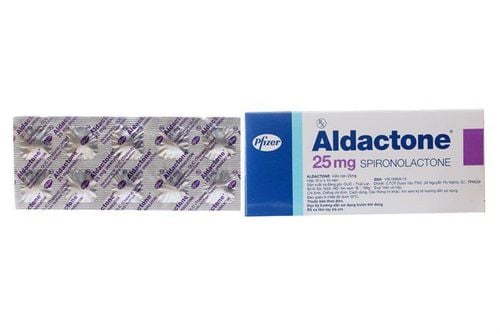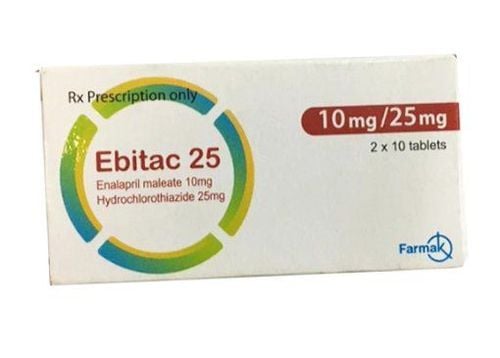This is an automatically translated article.
Valbelis is a combination antihypertensive drug between two different ingredients. When combining drugs, it will increase the antihypertensive effect, helping to treat high blood pressure cases where the use of single drugs does not bring the desired therapeutic effect.
1. What is Valbelis?
Valbelis medicine has the main ingredient Valsartan 80mg; Hydrochlorothiazide 12.5mg, is available as a film-coated tablet. Valsartan is an antihypertensive drug of the angiotensin II (Ang II) receptor antagonist class. The drug acts selectively on the AT1 receptor, which controls the action of angiotensin II. Angiotensin II concentrations increase in serum when the AT1 receptor is inhibited by valsartan leading to activation of the AT2 receptor, which has a counterbalanced effect with AT1 but does not cause obvious physiological manifestations. Angiotensin II binds to a number of specific receptors on cell membranes in tissues, the AT1 receptor, causing a variety of physiological effects including direct and indirect involvement in blood pressure regulation. When attached to the AT1 receptor, the drug is capable of causing vasoconstriction, increasing pulse pressure directly. In addition, it has the effect of enhancing salt retention and stimulating aldosterone secretion. When taking Valsartan, the drug does not bind to the AT1 receptor to cause vasoconstrictor effects, thereby helping to lower blood pressure.
Hydrochlorothiazide is a drug that increases the diuresis of sodium chloride and associated water. The drug works by inhibiting the reabsorption of sodium and chloride ions in the distal tubule. The excretion of other electrolytes is also increased, especially potassium and magnesium, while calcium is decreased. Hydrochlorothiazide also reduces carbonic anhydrase activity, thus increasing bicarbonate excretion, this effect is usually small compared to the effect of chloride ion excretion and the drug does not significantly change urine pH. Thiazides have a moderate diuretic effect. Hydrochlorothiazide has, therefore, antihypertensive effects, primarily due to a decrease in plasma volume and extracellular fluid associated with sodium diuresis. Later in the course of drug administration, the antihypertensive effect increases depending on the decrease in peripheral resistance, through the gradual adaptation of blood vessels to the decrease in sodium ion concentration. Therefore, the antihypertensive effect of hydrochlorothiazide appears slowly after about 1-2 weeks, while the diuretic effect occurs rapidly and can be seen as soon as a few hours. Hydrochlorothiazide in combination enhances the effect of other antihypertensive agents.
2. Uses of Valbelis
Thanks to the combination of 2 antihypertensive components, the drug is indicated:
Treatment of essential or secondary hypertension. Treatment of hypertension in patients whose blood pressure is not adequately controlled on monotherapy. Valbelis should not be used in the following cases:
Patients with hypersensitivity to any ingredient of the drug. Do NOT use for pregnant. Severe liver failure, biliary cirrhosis and cholestasis. Anuria, severe renal impairment (creatinine clearance < 30 ml/min). Hypokalemia and hyponatremia, persistent hypercalcemia and hyperuricemia.
3. Dosage and how to take Valbelis
How to use: The drug is taken orally, should be taken with water at the same time of day to maintain the antihypertensive effect.
Dosage:
Adults: The recommended therapeutic dose of is one film-coated tablet per day. To achieve an effective clinical response, 80 mg of valsartan and 12.5 mg of hydrochlorothiazide can be used or increased doses of valsartan and 12.5 mg of hydrochlorothiazide can be increased to 160 mg and 12.5 mg. In case of necessity, up to 160mg of Valsartan and 25mg of Hydrochlorothiazide can be used. The maximum antihypertensive effect is usually achieved within 2 to 4 weeks of treatment. Patients with hepatic impairment, renal impairment: No dose adjustment is required for patients with mild to moderate renal impairment (creatinine clearance > 30ml/min). No dose adjustment is required for patients with mild to moderate hepatic impairment of non-cholestatic causes. Children: The safety and effectiveness of Valbelis have not been established in children.
4. Valbelis side effects
Side effects can occur when you take Valbelis medicine, although not everyone when taking this medicine will experience this side effect. Some side effects include:
Headache, dizziness, fatigue, upper respiratory infection, cough, back pain. Uncommon side effects include: Abdominal pain, vision changes, anxiety, joint pain, arthritis, bronchitis, indigestion, shortness of breath, impotence, insomnia, cramps, urinary frequency, heartbeat. rapid, rash, tendon damage and muscle strain, urinary tract infection, viral infection, edema, weakness, dizziness. Rare: Angioedema, rash, pruritus and hypersensitivity reactions including serum sickness and vasculitis may be observed. Sensitivity to light, constipation, diarrhea and abdominal distension, intrahepatic cholestasis or jaundice, arrhythmia, headache, dizziness, sleep disturbance, depression, paresthesia, visual disturbance, decreased platelets, sometimes purpura may occur. Very rare: Necrotizing vasculitis and toxic epidermal necrolysis, lupus erythematosus-like skin reactions, lupus erythematosus reactivation, pancreatitis, leukopenia, agranulocytosis, renal failure bone marrow, hemolytic anemia, respiratory failure (including pneumonia and pulmonary edema). Very rare cases of impaired renal function have also been reported. Subclinical changes: Decreased blood potassium; Increased serum creatinine. When using, if you find any unusual problems, please inform your doctor or pharmacist for advice or timely handling.
5. Notes when using Valbelis
Due to hypokalemia has been reported in the case of thiazide diuretics. Therefore, it is necessary to regularly check the concentration of potassium in the serum. In addition, thiazide diuretic therapy has been associated with hyponatremia and hypochloremia. Thiazides increase urinary magnesium excretion and may lead to hypomagnesemia. It is also important to note these risks in the patient. In cases of salt depletion or patients with severe volume depletion due to high doses of diuretics, symptoms of severe hypotension may occur with use. Adequate saline and fluid replacement must be performed prior to initiation of drug therapy. If hypotension occurs during administration of the drug, the patient should be placed in supine position, if necessary, normal saline infusion should be given. Note when using for patients with renal artery stenosis or lupus erythematosus: In patients with unilateral or bilateral renal artery stenosis, the safety of using the drug has not been established. Systemic lupus erythematosus requires caution because there are reports of thiazide diuretics aggravating or activating systemic lupus erythematosus. Women who are pregnant or planning to become pregnant should not take this antihypertensive drug. Lactation: It is not known whether Valsartan is excreted in human milk. Therefore, it should not be used by nursing women. Maintain a proper diet and exercise regimen while taking the medication to increase its effectiveness and help reduce the need to increase the dose.
6. Drug interactions
Some possible interactions when using drug combinations:
The antihypertensive effect of Valbelis is increased when combined with other antihypertensive drugs. When taking the drug in combination with potassium supplements, potassium-sparing diuretics, salt substitutes containing potassium, or drugs that increase serum potassium levels (heparin...) potassium in the patient's serum. Sedatives: Reversible increases in serum sedation concentrations and toxicity have been reported with co-administration of ACE inhibitors and thiazides. Care should be taken when combining these drugs. Concomitant use with non-steroidal anti-inflammatory drugs may reduce the diuretic and antihypertensive effects of the thiazide component. Reduced blood flow and may lead to acute kidney failure. The hypokalemic effect of diuretics may be enhanced by the use of potassium-sparing diuretics, corticosteroids, ACTH, amphotericin, carbenoxolone, penicillin G and salicylic acid derivatives. It has been shown that it is necessary to adjust the dose of insulin and oral antidiabetic agents when co-administered with this antihypertensive agent. Storage: Valbelis should be stored in a cool place, away from direct sunlight and out of reach of children.
Hopefully with the information about the drug you already know the use, use and dosage of Valbelis. This is a drug that is used under the prescription of a doctor, you do not arbitrarily use it to avoid health effects.
Please dial HOTLINE for more information or register for an appointment HERE. Download MyVinmec app to make appointments faster and to manage your bookings easily.













